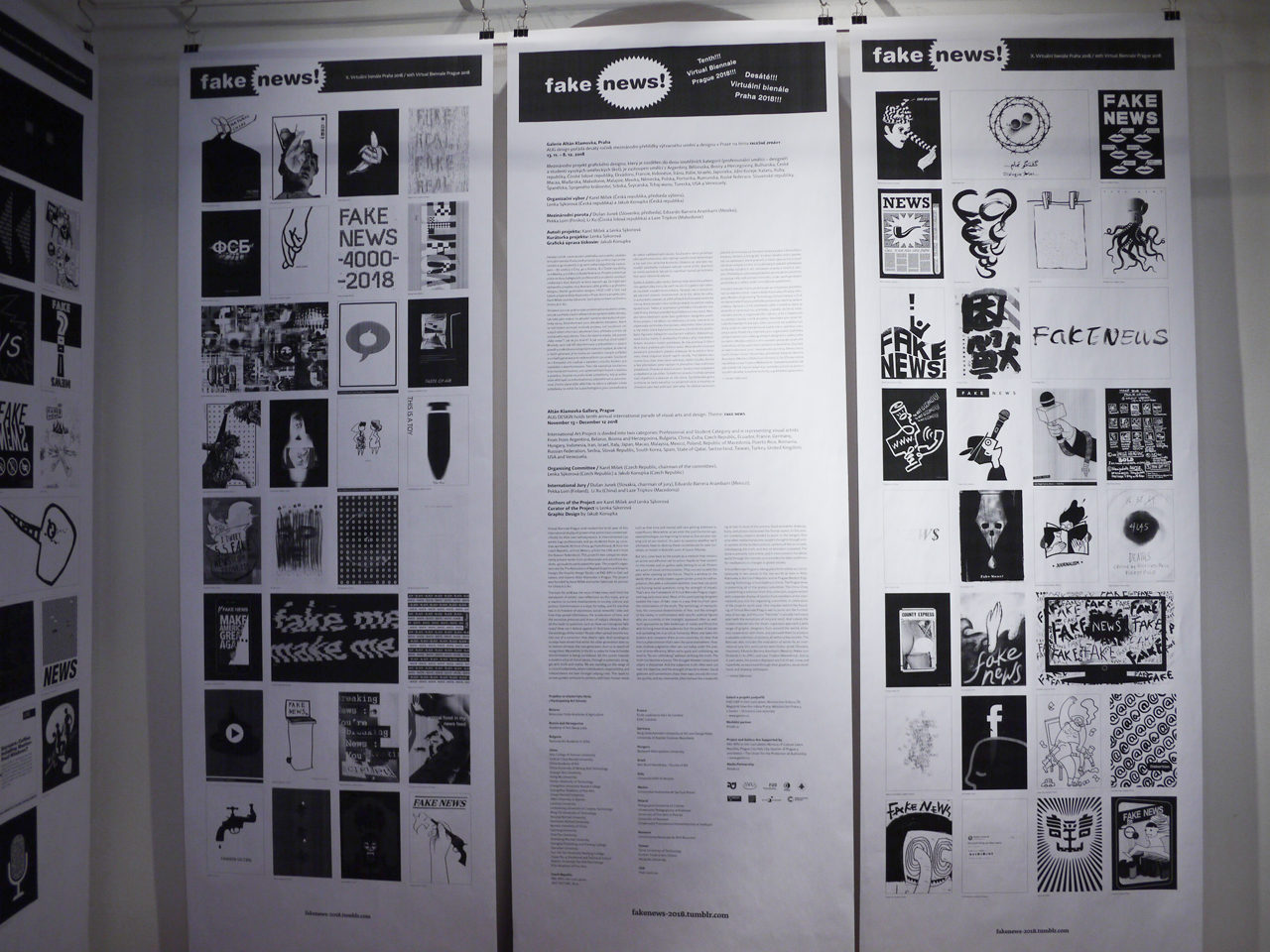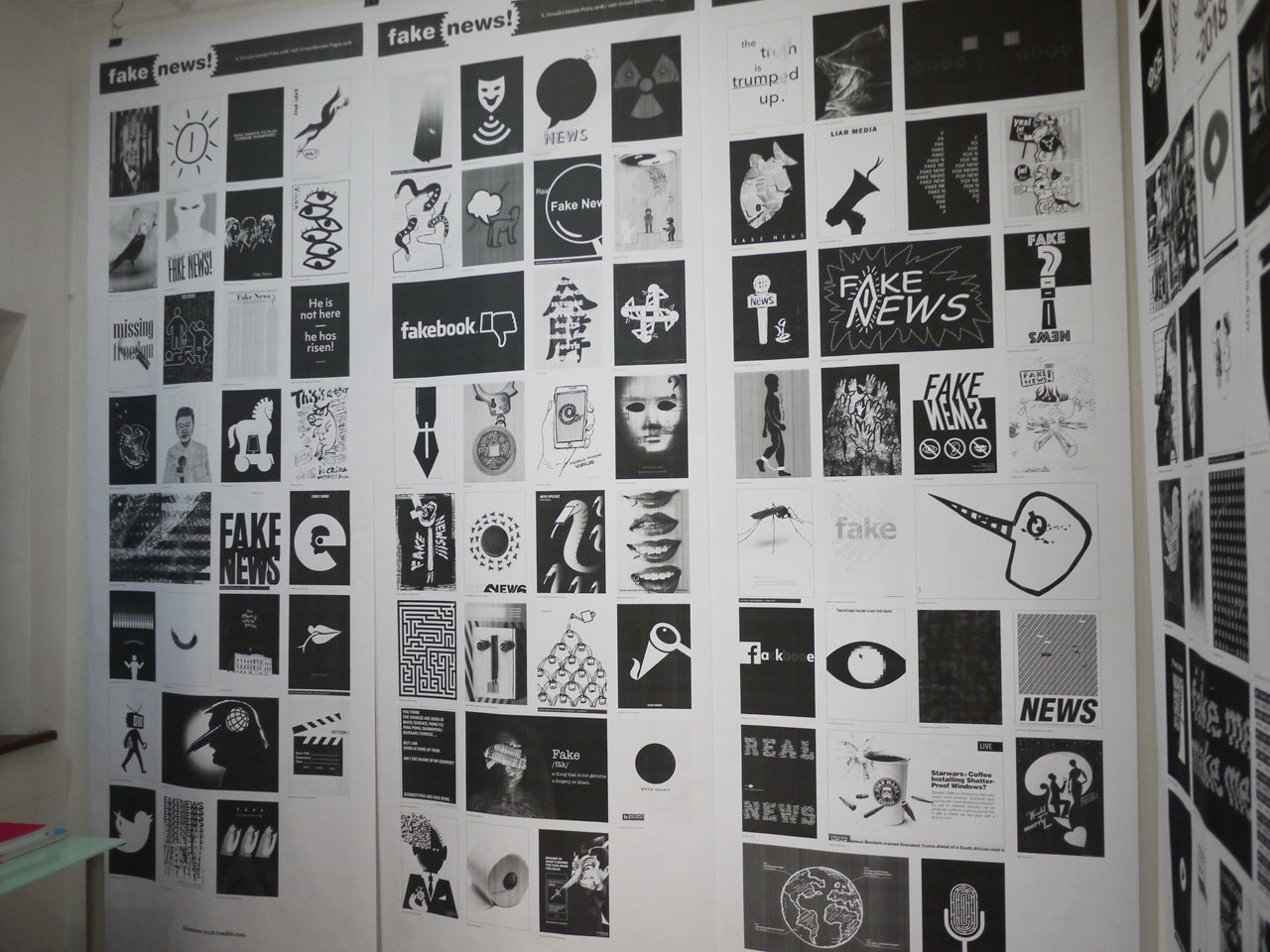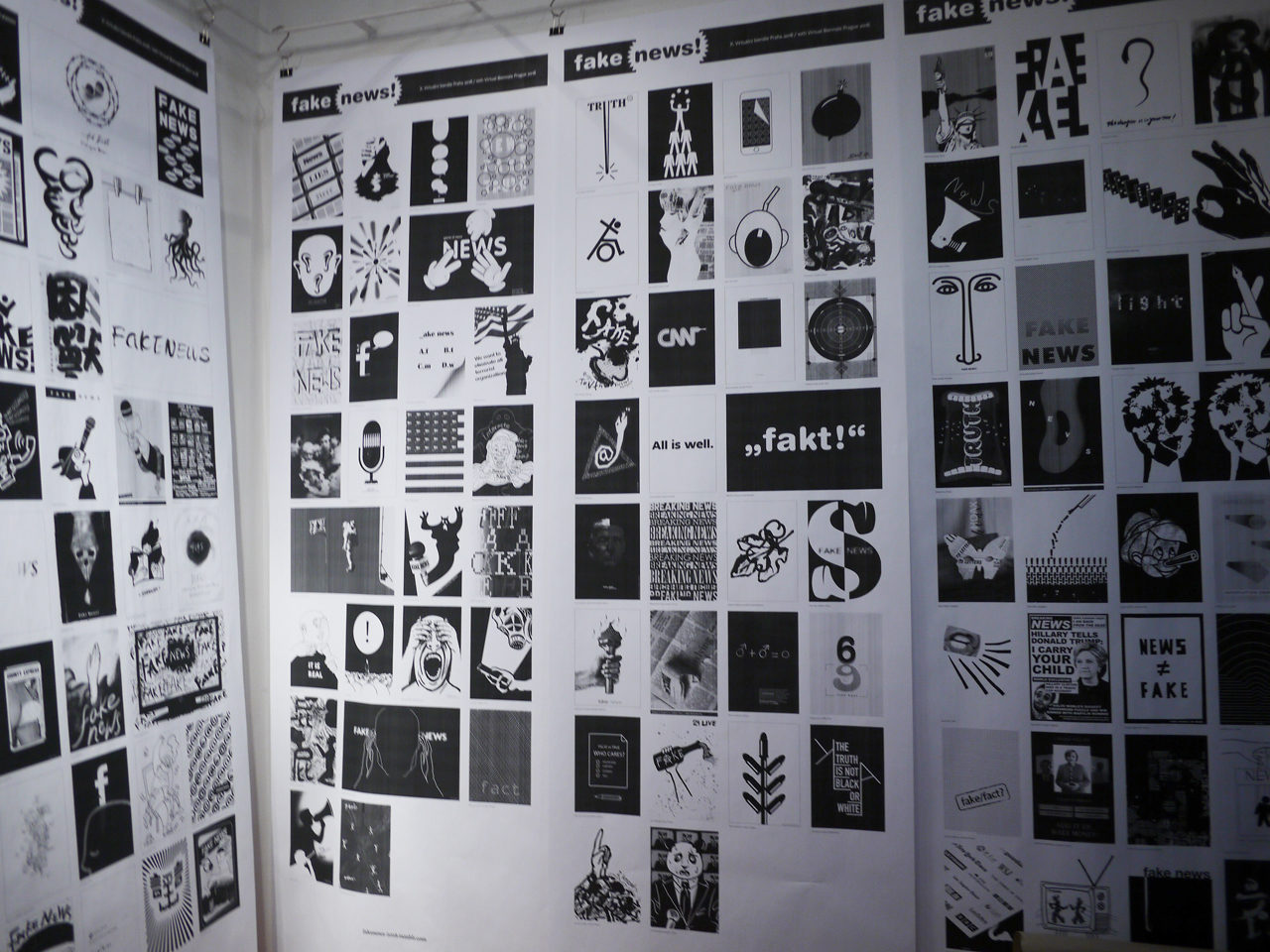Tenth Virtual Biennale Prague 2018
AUG DESIGN – holds tenth annual international parade of visual arts and design.
Theme: FAKE NEWS
International Art Project is divided into two categories: Professional and Student Category and is representing visual artists from from Argentina, Belarus, Bosnia and Herzegovina, Bulgaria, China, Cuba, Czech Republic, Ecuador, France, Germany, Hungary, Indonesia, Iran, Israel, Italy, Japan, Macao, Malaysia, Mexico, Poland, Republic of Macedonia, Puerto Rico, Romania, Russian Federation, Serbia, Slovak Republic, South Korea, Spain, State of Qatar, Switzerland, Taiwan, Turkey, United Kingdom, USA and Venezuela.
An opening of the exhibition on Tuesday, November 13, 2018, from 6 pm
The exhibition until December 8, 2018, opening hours Wednesday and Saturday from 1 to 5 pm
Introductory word and results announcement by Karel Míšek
Authors of Project are Karel Míšek and Lenka Sýkorová
Curator of Project is Lenka Sýkorová
Graphic design by Jakub Konupka
organising committee / Karel Míšek (Czech Republic, chairman of the committee), Lenka Sýkorová (Czech Republic) a Jakub Konupka (Czech Republic)
international jury / Dušan Junek (Slovakia, chairman of the jury), Eduardo Barrera Arambarri (Mexico), Pekka Loiri (Finland), Li Xu (China) and Laze Tripkov (Macedonia)
Accompanying program on Saturday, December 8, 2018, 2:00 – 4:00 pm – animation workshop for children, 4:00 – 5:00 pm – commented viewing of the exhibition and the exhibition activity of Klamovka Pavilion.
Virtual Biennale Prague 2018 marked the tenth year of this international display of posters that artists have created specifically for their own self-expression. It interconnected 232 artists (142 professionals and 90 students) from 35 countries worldwide: 87 from China, 40 from Poland, 18 from the Czech Republic, 10 from Mexico, 9 from the USA, and 7 from the Russian Federation). This project’s two categories separately present works from professionals and art-school students. 49 students participated this year. The project’s organizers are the Applied Arts Association, the 1 FUD UJEP Graphic Design Studio in Ústí nad Labem, and Galerie Altán Klamovka in Prague. The project was founded by Karel Míšek and Lenka Sýkorová. Its partner for China is Li Xu.
The topic for 2018 was the issue of fake news, both from the standpoint of artists’ own reflections on this topic, and as a reaction to current developments in society, culture, and politics. Disinformation is a topic for today, and it’s one that ties into freedom of expression, social networks’ roles and how they spread information, the acceleration of time, and the excessive pressure and stress of today’s lifestyles. And all this leads to questions, such as: How can I recognize fake news? How can I defend against it? And how does it affect the workings of the media? People often spread misinformation out of a conviction that they’re right. And sociological surveys have shown that while the older generation does so to restore old ways, the new generation does so in search of recognition. Meanwhile, in the EU a codex for how to handle disinformation is being considered. All this points towards a modern crisis of moral values, through a systematic struggle with truth and reality. We are standing on the verge of a crisis of subjectivity, where individualism, responsibility, and independence are ever stronger rallying cries. This leads to an ever-greater pressure to perform, with basic human needs such as free time and mental self-care getting sidelined as superfluous. Meanwhile, as we enter the post-humanist age, new technologies are beginning to serve us, but are also slipping out of our control. It’s open to question whether we’ll ultimately have to destroy these conveniences to save ourselves, as hinted in Kubrick’s 2001: A Space Odyssey.
But let’s come back to the poster as a medium that remains an active and effective call to action thanks to how posters on the streets and on gallery walls belong to us all. Posters are part of visual communication. They connect us with the past while opening up the future. They’re a window to the world. When an artist creates a given poster purely for self-expression, this adds a cultivated aesthetic level that can point out burning social questions using the strength of visuals. That’s also the framework of Virtual Biennale Prague, organized regularly since 2007. Most of the participating designers tackled the topic of fake news in a way that touched upon the relativization of the truth. The symbology of manipulation, the conscious dissemination of fear, and the strength of the media, in confrontation with specific political figures who are currently in the limelight, appeared often as well. Such approaches as fake backdrops of reality and Pinocchio with his long nose show audiences that the power of slander and spreading lies is as old as humanity. When one takes the posters and compares them across countries, it’s clear that this is a phenomenon that’s seen the same everywhere. However, shallow judgments often win out today under the pressure of time efficiency. When we’re quick and unthinking, we tend to “do our unthinking” without verifying the truth. The truth has become a luxury. The struggle between subject and object is sharpened. And the subjective truth often wins out over the objective, and the strength of words is shown. Social gestures and conventions chase their ways around the internet quickly, and we, meanwhile, often behave like a snake biting its tail. In most of the posters, black-and-white drawings, fonts, and photos dominated the formal aspect. In the posters’ contents, creators tended to point to the dangers that arise when media manipulate people’s thoughts through public opinion. In the student posters, symbols of the social web, sidestepping the truth, and fear of alienation prevailed. The show is primarily held online, and it interconnects the whole world through the internet, so it provides the ideal conditions for meditations on changes in a global society.
Virtual Biennale Prague is taking place both online and simultaneously in two places in the real world: at Galerie Altán Klamovka in the Czech Republic and at Pingyao Modern Engineering Technology School Gallery in China. The Prague show is presenting all of the posters submitted. The China show is presenting a selection from this collection, supplemented with a separate display of posters from members of the international jury and the organizing committee, in celebration of the project’s tenth year. One impulse behind the founding of Virtual Biennale Prague was to point out the hurriedness of our age, and thus our “biennale” is actually held every year (with the exceptions of 2013 and 2017). And indeed, the modern internet lets the show’s organizers approach a wide range of graphic designers from around the world, enter into cooperation with them, and persuade them to produce a valuable collection of posters, all within a few months. The Biennale also includes the evaluation of works by an international jury; this year’s jurists were Dušan Junek (Slovakia, chairman), Eduardo Barrera Arambarri (Mexico), Pekka Loiri (Finland), Li Xu (PRC), and Laze Tripkov (Macedonia). Just as in past years, the posters displayed are full of wit, irony, and hyperbole, as expressed through their graphics, visual shorthand, and drawing techniques.
Lenka Sýkorová
Participating Art Schools:
Belarus: Belarusian State Academy of Agriculture,
Bosnia and Herzegovina: Academy of Arts Banja Luka,
Bulgaria: National Art Academy in Sofia, Bulgaria
China:
Arts College of Sichuan University,
Central China Normal University,
China Academy of Art,
China University of Mining And Technology,
Guangxi Arts University,
Hsing Wu University,
Hunan University of Technology,
Changzhou University Huaide College,
Guangzhou Academy of Fine Arts,
Jiangxi Normal University,
JiMei University in Xiamen,
Lanzhou University,
Limkokwing University of Creative Technology,
Ming Chi University of Technology,
Nanjing Normal University,
Northeast Normal University,
Renmin University of China,
Sanming University,
ShanTou University,
Shandong Normal University,
Shanghai Publishing and Printing College,
Shenzhen University,
Sun Yat Sen University Nanfang College,
Yuyao No.4 Vocational and Technical School,
Xiamen University Tan Kah Kee College
Xi'an Academy of Fine Arts,
Czech Republic:
FAD JEPU, Ústí nad Labem,
FAST VUT ARC, Brno
France:
École supérieure d'art de Cambrai,
ESAC Cambrai,
Germany:
Burg Giebichenstein University of Art and Design Halle,
University of Applied Sciences Mannheim
Hungary: Budapest Metropolitan University
Israel: Beit Berel Hamidrasa – Faculty of Art,
Italy: Università IUAV di Venezia
Mexico: Universidad Autónoma de San Luis Potosí,
Poland:
Pedagogical University of Cracow,
Uniwersytet Pedagogiczny w Krakowie,
University of Fine Arts in Poznan,
University of Rzeszow
Uniwersytet Przyrodniczo-Humanistyczny w Siedlcach,
Romania: Universitatea Nationala de Arte Bucuresti
Taiwan:
China University of Technology
Fu-Hsin Trade & Arts School,
Hsing Wu University,
USA: Pratt Institute.


